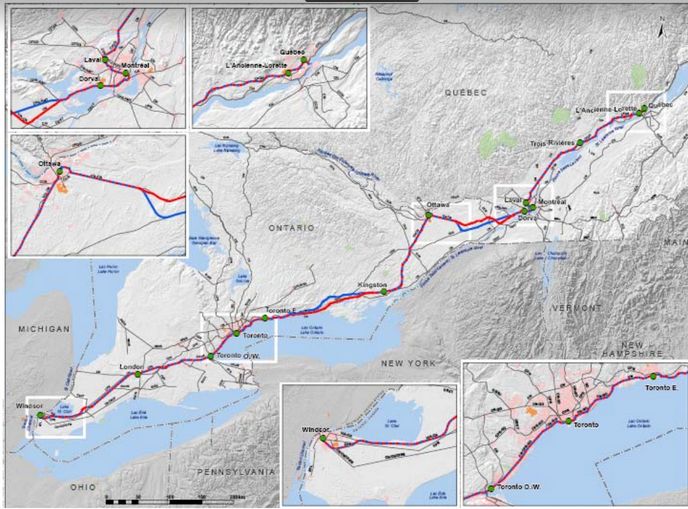I thought I had already said everything which needed to be said about the "Ottawa Bypass" back in July (that it's better to document now why the Ottawa Bypass is a bad idea, then to have that question unexpectedly emerge at a later point where it could actually delay a funding decision), but if anyone wants to revisit why operating the Toronto-Ottawa-Montreal triangle with non-stop express services (i.e. like airlines) rather than a trunk network (like, you know, actual intercity rail corridors all over the planet), a good start would be here:
***
In the meanwhile, let's do a little thought experiment, based on a quick-and-dirty back-of-the-envelop calculation:
Let's consider first the HFR proposal as a single TRTO-OTTW-MTRL trunk line, with the
cost figures the Globe and Mail mentioned back in 2019 ($2.1 billion for TRTO-OTTW and $91.5 million for OTTW-MTRL), together with the frequencies mentioned in the same article. In that case, if we divide the capital costs by the number of train-km these segments would see over an assumed asset life of 40 years, the capital costs would be equivalent
$8.63 per train-km ($12 per train-km for TRTO-OTTW, $1.16 for OTTW-MTRL).
Now suppose that
after construction of HFR for these 15 frequencies from Toronto via Ottawa to Montreal has begun, someone comes and proposes to build an Ottawa Bypass, in order to operate 6 additional trains skipping Ottawa (IIRC, this figure was suggested by
@crs1026 in a previous post).
The important thing here is to understand that HFR has now become the base case and we are assessing only the
incremental cost effect of the Ottawa Bypass.
In lack of exact cost estimates, let's assume that the construction of the Ottawa Bypass will incur the same per-km cost as the TRTO-OTTW-MTRL trunk line (i.e. $3.78 million), resulting in an
additional capital cost of $552 million.
These 146 km of additional route-km would carry an annual volume of 4,380 trains and 639,480 train-km.
Therefore, the capital cost of the Ottawa Bypass is equal to
$21.57 per train-km (thus 1.8 times the respective figure for TRTO-OTTW, 2.5 times for the entire Base Case and a whopping 19 times the OTTW-MTRL segment).
I'm 100% certain someone intelligent will now point out that the Express trains operate over the entire 546 km [calulation:
580 km TRTO-OTTW-MTRL plus 146 km Ottawa Bypass minus 180 km SMTF-OTTW-De Beaujeu] and therefore the $3,148 incremental capital costs for every train movement over the Ottawa Bypass should be divided by the entire 546 km, not just the 146 km of the Ottawa Bypass. However, if these Express trains were diverted via Ottawa instead, the incremental capital cost would be
zero rather than $552 million. Therefore, the entirety of the capital costs of the Ottawa Bypass is caused excusively by the 146 km travelled on the Ottawa Bypass, not the 400 km traveled on the regular HFR network, (which is already under construction and thus a
fait accompli in our thought experiment)...
Please find my calculations below:
| Metric | HFR TRTO-OTTW | HFR OTTW-MTRL | HFR TRTO-OTTW-MTRL (Base Case) | Ottawa Bypass | vs. HFR without Ottawa Bypass |
|---|
| Capital Cost | $2.1 billion | $91.5 million | $2.19 billion | $552 million | +25% |
| Segment length | 400 km | 180 km | 580 km | 146 km | +25% |
| Frequencies/day | 15 | 15 | 15 | 6 | +40% |
| Trains/year | 10,950 | 10,950 | 10,950 | 4,380 | +40% |
| Train-miles/year | 4,380,000 | 1,971,000 | 6,351,000 | 639,480 | +10% (ignoring everything outside the Ottawa Bypass) |
| Capital cost per km | $5.25 million | $0.51 million | $3.78 million | $3.78 million | same (assumed) |
| Capital cost per year (assuming 40-year asset life) | $52.5 million | $2.29 million | $54.79 million | $13.79 million | +25% |
| Capital cost per train movement | $4,794 | $208.90 | $5,003 | $3,148 | 63% (ignoring everything outside the Ottawa Bypass) |
| Capital cost per train-km | $11.99 | $1.16 | $8.63 | $21.57 | 250% |
Thank you and have a good night, everyone!
PS: Feedback of any kind is highly welcome, but with the expectation that objections include constructive suggestions of how to correct/expand/refine/improve above table...





